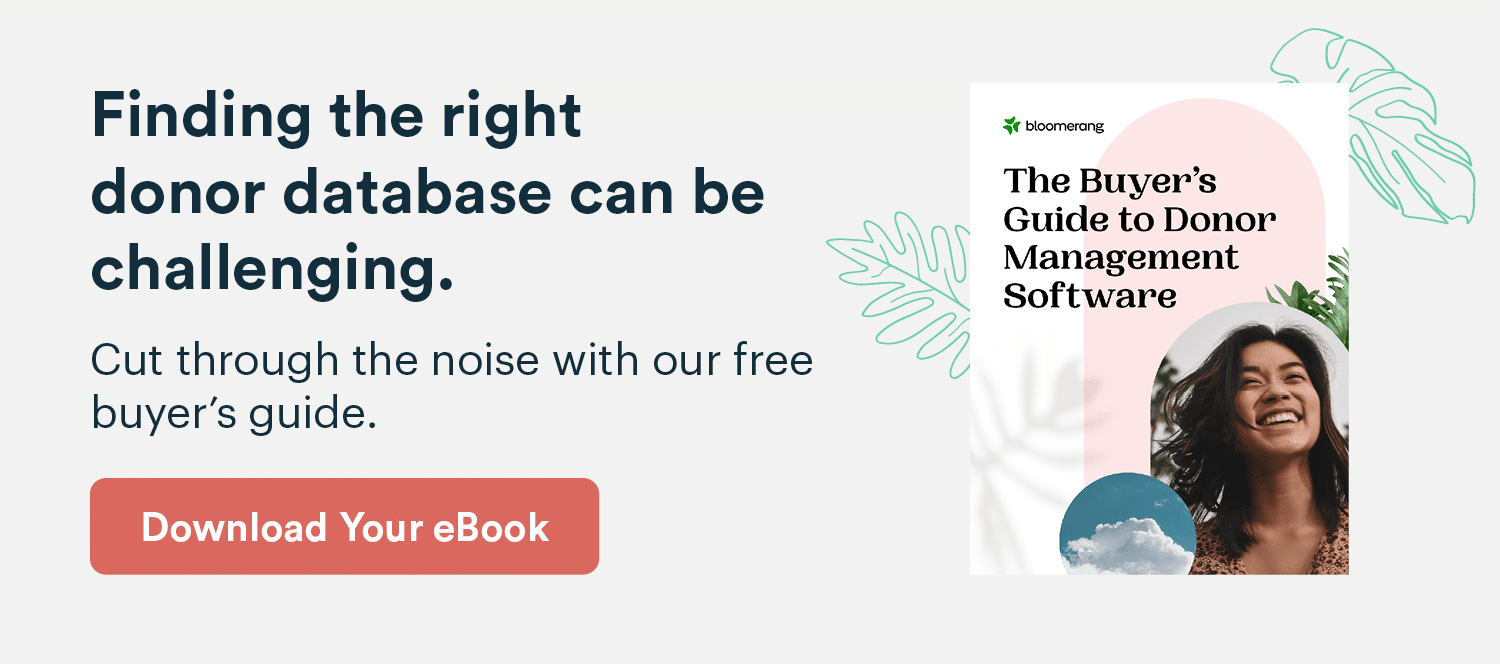What is a Nonprofit or Donor Database? What You Need to Know

When it comes to nonprofit software solutions, a donor database or constituent relationships management system (CRM) is among the most important. In fact, 67% of nonprofits use a CRM to track donations and manage supporter relationships.
Donor databases help nonprofits organize supporter data, keep track of donor interactions, and personalize donor outreach. In this guide, we’ll cover a few commonly asked questions about donor databases, including:
- What is a donor database?
- Can I use spreadsheets to track my donors?
- How does a donor database benefit nonprofits?
- How can I use donor data to connect with my donors?
- Is there free donor database software?
- What features should I look for in a donor database?
- What are the top donor databases available?
- How can I choose the right donor database?
- What are other types of nonprofit databases?
What is a donor database?
A donor database is the software system or central hub that nonprofits use to store and track donor information. This information includes everything from their contact information and giving history to their interests and past involvement with the organization.
Nonprofits might use spreadsheets or CRM software, also known as donor management software, to manage their donor database.
Can I use spreadsheets to track my donors?
Spreadsheets can be used in place of a donor database, but updating and maintaining these sheets requires more time and energy. Plus, spreadsheets are more prone to human error. On the other hand, databases allow users to manipulate large amounts of data at once and find the information they need through simple search queries.
Whether or not your nonprofit is ready to move away from spreadsheets and toward a database will depend on your organization’s size and specific needs. To help make your decision, review Bloomerang’s guide to choosing your first donor database. This resource includes information about the benefits of a donor database and how to choose the right option for your organization.
How does a donor database benefit nonprofits?
Donor databases keep all the information nonprofits need in one place and are outfitted with tools that help with every aspect of running an effective organization.
Plus, a donor database helps you track key information about your contacts. Ultimately, you can use this information to build genuine relationships with your donors.
Beyond basic contact information, your donor database might be able to track and store:
- Donors’ birthdays or anniversaries
- Name(s) of their spouses or children
- Their communication preferences
- Employment information
- Passion projects within the organization
- Why or how they give
- Their giving patterns
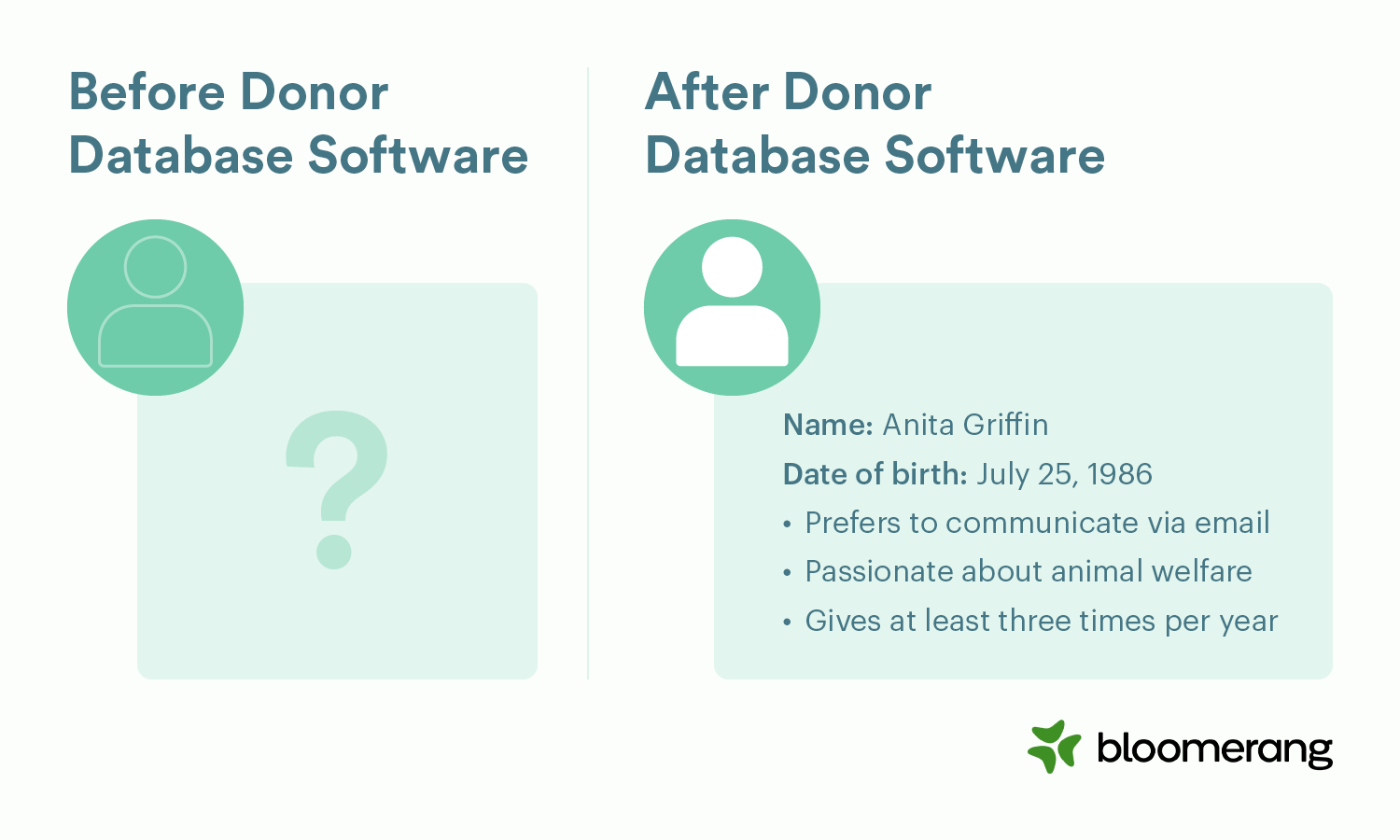
This kind of data will help you understand your donors better and communicate with them in a way that appeals to their interests.
How can I use donor data to connect with my donors?
So, how can you put your donor data to work to actively improve donor relationships? Let’s take a look at a specific example.
Imagine you have a donor named Melody Michaels. You create a donor profile for Melody in your donor database and fill it with a variety of information, including her birthday, employment information, and past volunteer history.
On her birthday, you send Melody a happy birthday email letting her know you’re thinking of her. Later, you review her employment data and see that Melody is eligible for a matching gift through her job at Verizon. After Melody donates to your Giving Tuesday campaign, you thank her for the gift and send her information about applying for a matching gift through her employer. Lastly, you send messages thanking Melody for her past volunteer work and showing her how your organization uses donations to fund supplies for volunteer opportunities.
As you can see, you can personalize each interaction your nonprofit has with supporters simply by using the information in your donor database.
Is there free donor database software?
Nonprofits looking for a low-cost way to take their operations online may be interested in free donor database software. However, a free donor database will likely only cover a growing organization’s basic needs (including general donor management and data storage) and may still require the use of spreadsheets.
Some free packages may be comprehensive but require a preliminary software investment to gain access to nonprofit-specific tools. For example, Salesforce offers a free Nonprofit Success Pack, but only for organizations with an existing Salesforce account. Free database software often also lacks the custom-tailored customer support of other platforms and will likely require some time and attention from an IT expert.
What features should I look for in a donor database?
Ensure that the donor database you invest in offers the features you need to track and report on donor data effectively. At a minimum, your donor database should include:
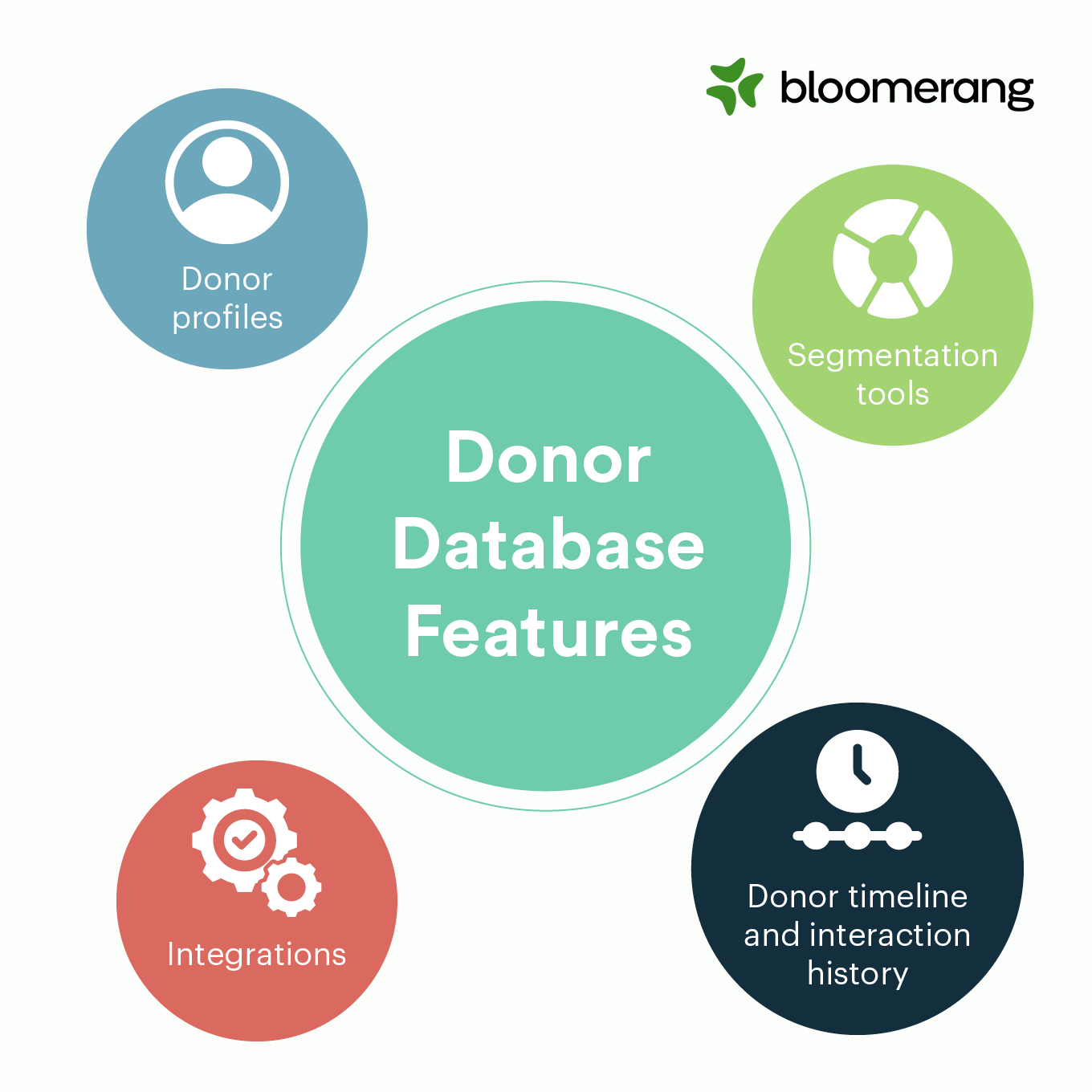
- Donor profiles. Donor profiles are the contacts within your donor database that store information such as donors’ full names, titles, giving histories, birthdays, personal connections to other donors or staff members, and other relevant data.
- Segmentation tools. These include the filters you can apply to your donor database that allow you to create donor groups and develop targeted communications for each segment.
- Donor timeline and interaction history. Knowing exactly how and when donors have interacted with your organization in the past is key to building genuine relationships. With a donor timeline, you can view each supporter’s past engagement, including donations, volunteer involvement, event attendance, and other interactions.
- Integrations. Your donor database should be able to integrate with other software platforms you’re already using. This might include your email marketing platform, event management system, and accounting software. Integrations ensure seamless data transfers between these platforms and your donor database software.
Top-of-the-line donor databases go above and beyond with specialized features that help automate data-tracking processes and supplement your internal data with additional information. We’ll cover a few top options later in the next section.
What are the top donor databases available?
We’ve rounded up eight popular donor database options to compare and help you start your search for the right tool for your organization:
Bloomerang

Donor database overview
Bloomerang is a donor management software solution that offers multiple essential tools for nonprofits, including a donor database, fundraising solution, volunteer management platform, marketing tools, and more.
Top features
Bloomerang’s robust donor database software offers helpful tools like:
- An interactive dashboard. Bloomerang offers an interactive dashboard to gain a bird’s-eye view of the state of your donor management efforts. This dashboard allows you to view your donor retention rate, measure your campaign success, and track incoming donations in real-time.
- Wealth screening. Bloomerang partners with DonorSearch, a trusted wealth-screening provider, to offer a Generosity Score™ for each supporter. This score reveals how likely a donor is to submit a major gift. You can use this metric to identify the major gift prospects that your organization should build relationships with.
- Engagement meter. The engagement meter assesses how engaged each supporter is based on their past interactions with your nonprofit, including donating, volunteering, and engaging with your marketing campaigns. Your most important major donor prospects will be those who exhibit high generosity and engagement scores.
- Nightly data updates. Bloomerang offers automatic nightly data updates, including updates for birthday and address information. Having accurate birthday and address information allows you to create donor segments based on birth year and ensure your direct mail outreach is going to the right homes.
These features will allow you to identify hidden fundraising potential within your existing supporter base, personalize your marketing outreach, and continue making the best use of the software solutions you already have.
Learn more about Bloomerang’s features in this video:
Pricing
Bloomerang’s scalable pricing starts at $119 per month for access to their donor database. Users have the option to add on additional functionality such as giving tools and payment processing.
Little Green Light

Donor database overview
Little Green Light’s donor management system helps centralize all tools nonprofits need in one place. This includes a donor database, fundraising solutions, and integrations with other leading platforms like Stripe and QuickBooks.
Top features
Little Green Light’s donor database includes tools that optimize every stage of the donor management process, including:
- Prospect identification tools
- Personalized communications and other contact management features
- Customized online donation forms and automated thank-you process
Pricing
Pricing starts at $486 per year.
Neon CRM
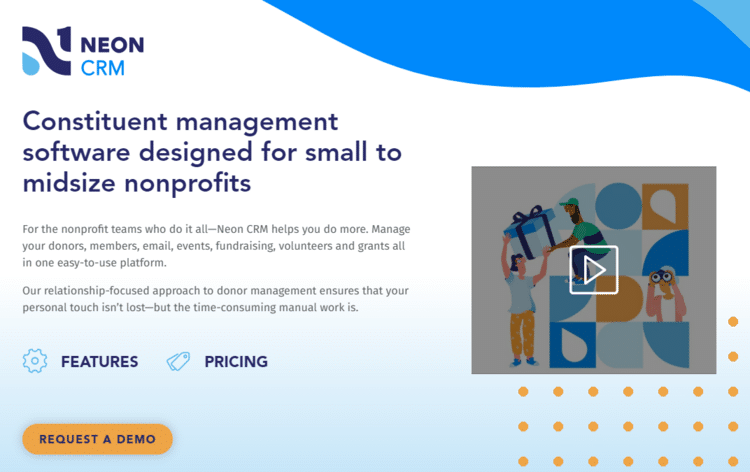
Donor database overview
Neon CRM is a constituent relationship management platform designed specifically for small and mid-sized nonprofits.
Top features
Neon CRM offers tools that make donor management easier for small shops, such as:
- A user-centric dashboard designed to increase productivity
- An engagement timeline to take note of every donor interaction
- Pre-built and custom reporting options
Pricing
Pricing starts at $99 per month.
Funraise
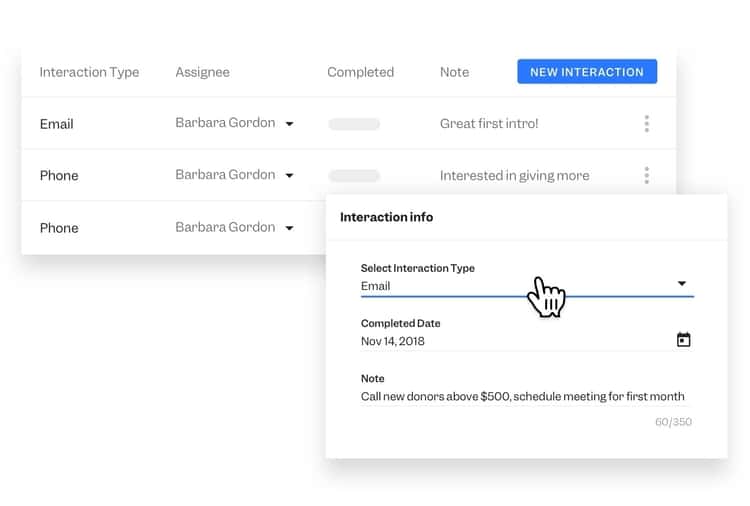
Donor database overview
Funraise provides free donor CRM software for nonprofits looking to manage their contacts more efficiently. Funraise can also integrate with Salesforce to automatically import Salesforce data and leverage advanced analytics.
Top features
Funraise empowers nonprofits with multiple features to engage supporters, including:
- Custom segmentation to filter and categorize supporters based on multiple criteria
- A donor portal app for donors to access their donation information
- Household management tools that allow you to see connections between supporters who are related in some way
Pricing
Funraise offers a free plan, as well as standard and premium options for organizations looking to access more features.
Blackbaud Raiser’s Edge NXT
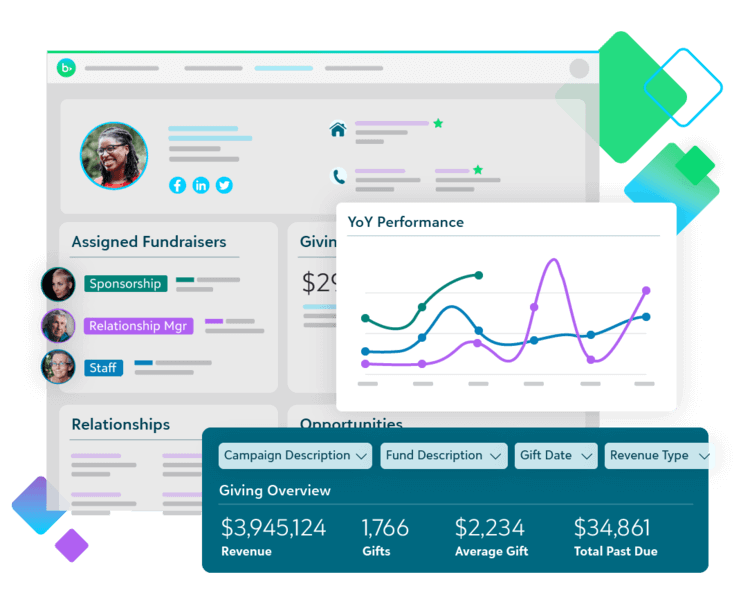
Donor database overview
Blackbaud Raiser’s Edge NXT maintains a strong focus on helping nonprofits boost their fundraising through data-driven fundraising tools and a robust CRM platform.
Top features
Raiser’s Edge NXT is equipped with smart fundraising tools like:
- AI-driven suggested giving amounts
- Comprehensive reporting dashboards for greater fundraising transparency across your team
- Recurring giving and pledge management to help develop a reliable donor base
Pricing
Contact Blackbaud for pricing.
DonorPerfect

Donor database overview
DonorPerfect specializes in fundraising and donor management software that helps facilitate cross-team collaboration for more efficient fundraising.
Top features
Nonprofits turn to the DonorPerfect platform for features like:
- Reports on the metrics that matter most to nonprofits, like donor retention and monthly fundraising trends
- Targeted, personalized solicitations based on gift size, recency, and other characteristics
- Personalized new customer onboarding and system implementation support
Pricing
Pricing starts at $99 per month. Contact DonorPerfect for a custom quote.
Givebutter
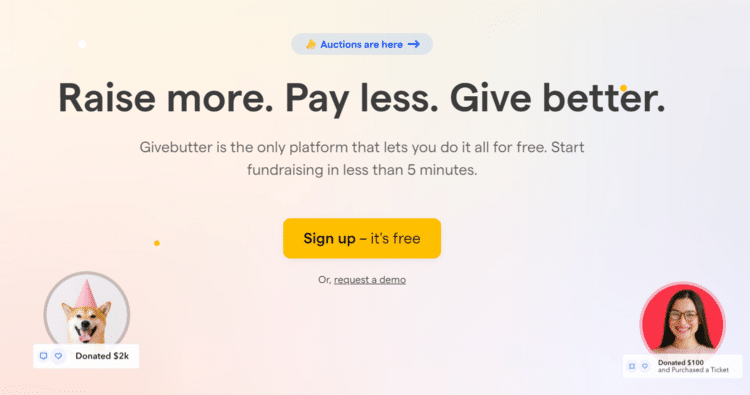
Donor database overview
Givebutter is another fundraising and donor management platform that offers a free option. Free donor database software is helpful for nonprofits looking to try out a system and see if it’s the right fit for their long-term needs.
Top features
With Givebutter, nonprofits can leverage donor database features like:
- Contact profiles complete with an engagement timeline and notes
- Fundraising, contact management, and event ticketing, all from one platform
- Data hygiene tools that help validate data and avoid duplication
Pricing
Givebutter has no platform fee but a 2.9% + 30¢ processing fee.
Virtuous
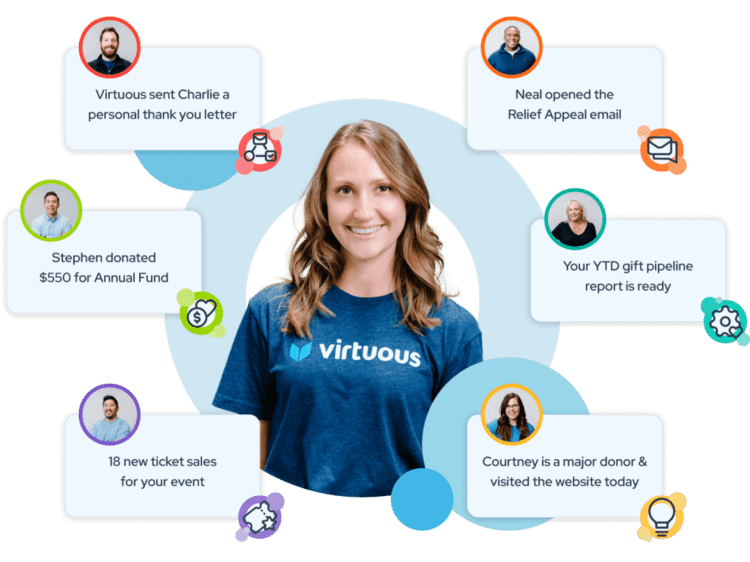
Donor database overview
Virtuous combines a nonprofit CRM, fundraising tools, volunteer management, and marketing tools into one platform for nonprofits to grow their giving.
Top features
Virtuous empowers nonprofits to raise more with features like:
- Real-time suggestions based on donor data, including wealth and demographic insights
- The ability to create personalized donor cultivation plans that include automated calls and email outreach
- Full-picture access to donor data with robust project and gift reporting
Pricing
Contact Virtuous for pricing.
How can I choose the right donor database?
Choosing the right donor database system for your nonprofit takes time and consideration. Follow these steps to find the best system to fit your needs:
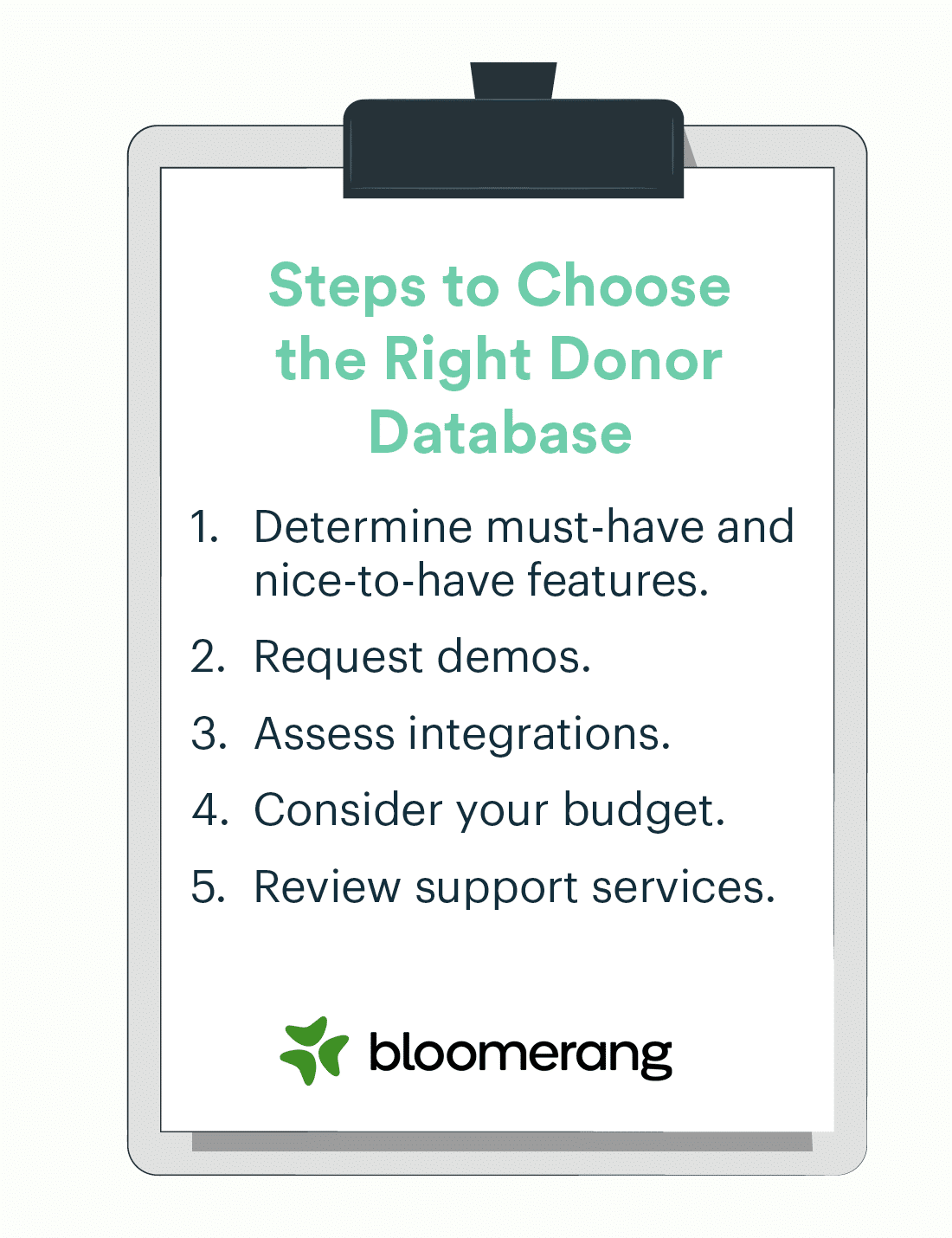
- Create a list of must-have and nice-to-have features. Define the features you absolutely need from your donor database and the ones that would be nice to have but aren’t essentials. When narrowing down your options, make sure your top choices offer all of your must-haves and several of your nice-to-haves.
- Request demos. Before making your final decision, request demos from each of your top options to see what the platforms look like in action. Make sure the staff members who will use your database the most can participate in the demos since their input will be especially valuable to the decision-making process.
- Assess your integration needs. Your donor database should be able to integrate with the other software solutions you’re already using, like your accounting or email marketing software. Ask about each platform’s integration options during the demo process.
- Consider your budget. Eliminate any options from your list that exceed your budget—these options will not lead to a high ROI. Also, it’s often worthwhile to look for a solution that offers a sliding payment scale based on the size of your organization. That way, the solution will grow alongside your nonprofit as you add more contacts to your database.
- Review support services. When transitioning to a new donor database system, you’ll need to migrate your data from your old system to your new one. Many donor management solutions offer professional support services to ensure your data transfers properly. Also, look for a provider that offers coaching and support services to help you make the most of your database.
Review our donor database buyer’s guide for more tips to help choose your first donor management software. The guide includes additional budgeting guidance and tips to ensure you’re making the best possible choice for your organization.
What are other types of nonprofit databases?
Donor databases aren’t the only types of nonprofit databases available. It’s helpful to look for a donor database that offers these additional databases already built-in or one that integrates with the other databases your nonprofit is already using. Let’s take a quick look at a few additional types of databases your organization could benefit from.
Volunteer database
Volunteer databases are the foundation of effective volunteer management. Volunteer databases offer tools for recruiting, training, scheduling, retaining, and communicating with volunteers.
Membership database
Membership databases make it easy for organizations to sell and manage memberships. Nonprofits can create membership portals where members can view exclusive updates from the organization’s work or update their membership information.
Fundraising database
Fundraising databases serve essentially the same functions as other nonprofit databases. They allow organizations to create fundraising campaigns, plan promotional materials, collect donor information, and process payment information.
Matching gift database
Matching gift databases enable donors to search for gift-matching information by providing a database of companies that have matching gift programs. Matching gift databases also make it possible for donors to submit matching gifts using the forms and instructions provided by the database.
The bottom line
Donor databases are essential for organizations looking to thrive in the digital world. Databases make it easy for organizations to perform necessary functions like collecting donor information, accepting donations, and sending donor communications.
Review these additional resources for more information on donor management processes and software:
- What is Donor Management Software? 11 Best Options for 2023. Donor management software is the tool nonprofits use to view their donor databases. Review the top solutions in this comprehensive guide.
- Major Gifts: The Ultimate Guide to Kickstart Your Program. Major gift fundraising becomes a lot easier when you use a robust donor database. Find out more about maximizing your major gift fundraising using your donor management system.
- Free Fundraising Software: Is It Worth It? Pros & Cons. Similar to donor database software, there are plenty of free fundraising solutions available. But are they worth it? Assess the pros and cons in this guide.


